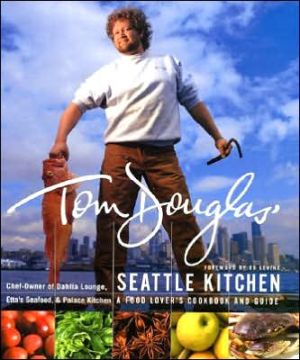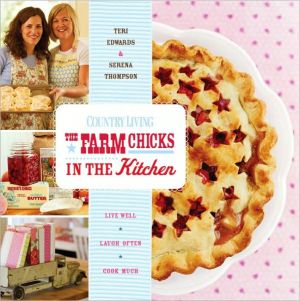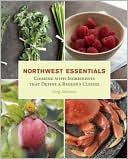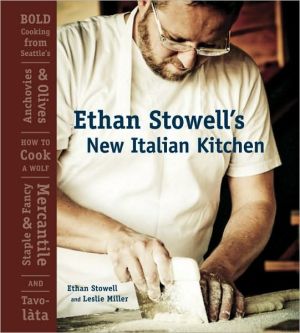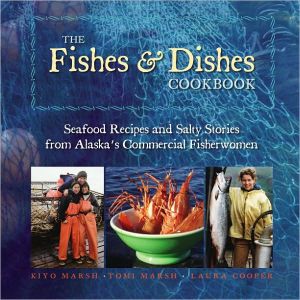Tom Douglas' Seattle Kitchen
There's a new culinary melting pot. It's called Seattle. Here you'll find everything from Japanese bento box lunches and Thai satays to steaming bowls of Vietnamese soups and all-American blackberry cobblers. No chef embodies this diversity with more flair and more flavor than chef/author/restaurateur Tom Douglas. And no book does it better than Tom Douglas' Seattle Kitchen.\ Tom's creativity with local ingredients and his respect for Seattle's ethnic traditions have helped put his three...
Search in google:
There's a new culinary melting pot. It's called Seattle. Here you'll find everything from Japanese bento box lunches and Thai satays to steaming bowls of Vietnamese soups and all-American blackberry cobblers. No chef embodies this diversity with more flair and more flavor than chef/author/restaurateur Tom Douglas. And no book does it better than Tom Douglas' Seattle Kitchen.Tom's creativity with local ingredients and his respect for Seattle's ethnic traditions have helped put his three restaurants and Seattle on the national culinary map. Join Tom and celebrate the Emerald City's rich culinary tradition: sweet I Dungeness crabs, razor clams, rich artisan cheeses, and deeply flavored Northwest beers. Share in the delight of sophisticated Washington wines, coffee fresh vegetables, fruits, and the exotic flavors of the Pacific Rim countries.Tom Douglas' style is laid-back sophistication with a dash of humor. You can see it in the names of his chapters, "Starch Stacking," "Slow Dancing," and "Mo' Poke, Dadu" (this last title, courtesy of his daughter, Loretta, means "More Pork, Daddy"). And you can taste it in his signature dishes such as Dungeness Crabcakes with Green Cocktail Sauce, Roast Duck with Huckleberry Sauce and Parsnip-Apple Hash, Udon with Sea Scallops in Miso Broth, and Triple Cream Coconut Pie.Try his hearty Long-Bone Short Ribs with Chinook Merlot Gravy and Rosemary WhiteBeans or spicy Fire-roasted Oysters with Ginger Threads and Wasabi Butter. Relax in the comfort of the comfort foods he prepares for his own family: Loretta's Buttermilk Pancakes with Wild Blackberries, Basic Barbecued Baby Back Ribs, and Five-Spice Angel Food Cake. They're all clear, simple recipes that'll have you cooking like Tom Douglas from the very first page.But this is more than a cookbook; it's a food lover's guide to Seattle. Join Tom on a tour of his city with his list of top ten best things to do — and eat — in Seattle, from his favorite ethnic markets and neighborhoods to where to get the best breakfast.Why not turn your kitchen into a Seattle kitchen? All it takes is a little help and inspiration from Tom Douglas. Lynne Rossetto Kasper I'd fly across the country to Tom Douglas' food. Now he's put it all down on paper. What I love about this book isn't just the kind of food I can't wait to cook myself, Tom also shares the extraordinary sources for his products. Washington State is the undiscovered Eldorado for food lovers. Tom is giving us the keys to the kingdom. Use this book in the kitchen, then take it with you to experience Tom's territory.
Dungeness Crabcakes With Green Cocktail Sauce\ Makes 8 appetizer or 4 entrée servings\ I brought this East Coast version of crabcakes with me when I moved here from Delaware about twenty-two years ago, but of course in Seattle I make them with the Northwest's sweet and delicious Dungeness crabmeat. Some modern versions of crabcakes are mostly crabmeat lightly bound with egg, but I'm a firm believer that a crabcake should contain bread crumbs. Bread crumbs made from cheap white bread are a key ingredient here: Ordinary store-bought white bread gives the crabcake just the right texture. And, of course, you need perfectly fresh, pristine crabmeat with plenty of big chunks of claw and leg meat.\ At both Dahlia Lounge and Etta's Seafood, Dungeness crabcakes is one of our most popular dishes and most requested recipes. Since this is a signature dish, we tend to be a little secretive about the recipe, but, what the hey, here it is.\ At Etta's the crabcakes come with French fries, coleslaw, and green cocktail sauce. At Dahlia Lounge we change the presentation often -- for example, they can be served with butternut-squash hash and an apple salad with Tabasco vinaigrette.\ 10 slices supermarket white bread (about 1/2 loaf)\ 3/4 cup chopped fresh flat-leaf parsley\ 1 large egg yolk (see Note, Page 24)\ 2 teaspoons fresh lemon juice\ 2 teaspoons Worcestershire sauce\ 1 1/2 teaspoons Tabasco sauce\ 7 teaspoons Dijon mustard\ 1/2 teaspoon paprika\ 1/2 teaspoon dried thyme\ 1/2 teaspoon celery seeds\ 1/4 teaspoon freshly ground black pepper\ 5 tablespoons olive oil\ 1 pound fresh cooked Dungeness crabmeat, picked\ over for bits ofshell and cartilage with claw meat\ and large pieces of crab left whole\ 1/4 cup chopped onions\ 1/4 cup seeded and chopped green bell peppers\ 1/4 cup seeded and chopped red bell peppers\ Unsalted butter for panfrying, about 6 tablespoons\ Green Cocktail Sauce (recipe follows)\ 4 to 8 lemon wedges\ \ 1. Tear up the white bread and pulse the pieces in a food processor to make fine, soft crumbs. (You should have about 6 cups crumbs.) Remove the bread crumbs to a shallow pan and mix in 1/2 cup of the chopped parsley (reserve the remaining 1/4 cup for the crabcake mixture). Set aside.\ 2. In a food processor, combine the egg yolk, lemon juice, Worcestershire, Tabasco, mustard, paprika, thyme, celery seeds, and black pepper and pulse to combine. With the motor running, slowly add the oil through the feed tube in a steady stream until the mixture emulsifies and forms a mayonnaise. Remove the mayonnaise from the food processor and refrigerate.\ 3. Place the crabmeat in a cheesecloth-lined sieve set over a bowl. Pull the cheesecloth tightly around the crabmeat and squeeze out as much juice as possible. Place the chopped onions and bell peppers in a sieve set over a bowl and use your hands to squeeze out as much juice as possible. In a large bowl, combine the onions and bell peppers with the remaining 1/4 cup parsley. Add the chilled mayonnaise and crabmeat and toss lightly to combine. Add 1 cup of the bread crumb-parsley mixture and combine. Do not overwork the mixture or the crabcakes may get gummy. Gently form 8 patties and roll the patties lightly in the remaining bread crumb-parsley mixture. Leave the crabcakes in the pan of bread crumbs until you sauté them.\ 4. Preheat the oven to 425°F. Using a nonstick sauté pan and butter as needed, panfry the crabcakes, in batches, until golden brown on both sides and place them on a baking sheet as they are browned. When all the crabcakes are browned, put them in the oven until they are heated all the way through, 5 to 8 minutes.\ On The Plate\ Serve one crabcake as an appetizer or two as an entrée. Serve with a ramekin of cocktail sauce and a lemon wedge.\ A Step Ahead\ The crabcakes actually hold together better if prepared a day ahead and stored in the refrigerator before cooking. Store them in the pan of bread crumbs, covered with plastic wrap.\ In The Glass\ A lightly oaked Chardonnay\ \ Triple Coconut Cream Pie\ Makes one 9-inch pie; 6 to 8 servings\ Who would have thought that this pie would be a best-seller twelve years in a row? We call it triple coconut cream pie because there is coconut in the pastry filling, coconut in the crust, and more coconut on top. To garnish the pie at the restaurant, we toast unsweetened coconut, which is available in very large, attractive "chips," and shave big curls of white chocolate over the top. You may be able to find unsweetened coconut chips or large-shred coconut in a natural foods store or in the bulk section of your supermarket. This recipe is adapted from our friend Jim Dodge's fine book American Baker (Simon & Schuster, 1987).\ For The Coconut Pastry Cream\ 2 cups milk\ 2 cups sweetened shredded coconut\ 1 vanilla bean, split in half lengthwise\ 2 large eggs\ 1/2 cup plus 2 tablespoons sugar\ 3 tablespoons all-purpose flour\ 1/4 cup (1/2 stick) unsalted butter, softened\ \ For The Pie\ One 9-inch Coconut Pie Shell (page 218),\ prebaked and cooled\ 2 1/2 cups heavy cream, chilled\ 1/3 cup sugar\ 1 teaspoon pure vanilla extract\ \ For Garnish\ 2 ounces unsweetened "chip" or large-shred coconut\ (about 11/2 cups) or sweetened shredded coconut\ Chunks of white chocolate (4 to 6 ounces, to make\ 2 ounces Of curls)\ \ 1. To make the pastry cream, combine the milk and coconut in a medium saucepan. Scrape the seeds from the vanilla bean and add both the seeds and pod to the milk mixture. Place the saucepan over medium-high heat and stir occasionally until the mixture almost comes to a boil.\ 2. In a bowl, whisk together the eggs, sugar, and flour until well combined. Temper the eggs (to keep them from scrambling) by pouring a small amount (about 1/3 Cup) of the scalded milk into the egg mixture while whisking. Then add the warmed egg mixture to the saucepan of milk and coconut. Whisk over medium-high heat until the pastry cream thickens and begins to bubble. Keep whisking until the mixture is very thick, 4 to 5 minutes more. Remove the saucepan from the heat. Add the butter and whisk until it melts. Remove and discard the vanilla pod. Transfer the pastry cream to a bowl and place it over a bowl of ice water. Stir occasionally until it is cool. Place a piece of plastic wrap directly on the surface of the pastry cream to prevent a crust from forming and refrigerate until completely cold. The pastry cream will thicken as it cools.\ 3. When the pastry cream is cold, fill the prebaked pie shell with it, smoothing the surface. In an electric mixer with the whisk, whip the heavy cream with the sugar and vanilla on medium speed. Gradually increase the speed to high and whip to peaks that are firm enough to hold their shape. Fill a pastry bag fitted with a star tip with the whipped cream and pipe it all over the surface of the pie, or spoon it over.\ 4. For the garnish, preheat the oven to 350°F. Spread the coconut chips on a baking sheet and toast in the oven, watching carefully and stirring once or twice, since coconut burns easily, until lightly browned, 7 to 8 minutes. Use a vegetable peeler to scrape about 2 ounces of the white chocolate into curls.\ On The Plate\ Cut the pie into 6 to 8 wedges and place on dessert plates. Decorate each wedge of pie with white chocolate curls and the toasted coconut.\ A Step Ahead\ If not serving immediately, keep the pie refrigerated, covered with plastic wrap. The finished pie should be consumed within a day. Prepare the garnishes just before serving. The coconut pastry cream can be made a day ahead and stored chilled in the refrigerator, covered with plastic wrap as described above. Fill the pie shell and top it with whipped cream and garnishes when you are ready to serve the pie.\ In The Glass\ Mouscato d'Asti, a delicious sweet sparkling white Muscat from Piedmont\ \ Coconut Pie Shell\ Makes one 9-inch shell\ In this recipe you need to blind-bake the pie shell: bake an unfilled pastry-lined pan. If you don't have special pie weights, use dried beans to weight the crust to keep it from puffing up during baking. You can store your pie beans in a jar and use them over and over.\ Very cold butter will give you a flakier crust. Put the diced butter in the freezer for 10 minutes before making your dough.\ 1 cup plus 2 tablespoons all-purpose flour\ 1/2 cup sweetened shredded coconut\ 1/2 cup (1 stick) cold unsalted butter, cut into 1/2-inch dice\ 2 teaspoons sugar\ 1/4 teaspoon kosher salt\ 1/3 cup ice water, or more as needed\ \ 1. In a food processor, combine the flour, coconut, diced butter, sugar, and salt. Pulse to form coarse crumbs. Gradually add the water, a tablespoon at a time, pulsing each time. Use only as much water as is needed for the dough to hold together when gently pressed between your fingers; don't work the dough with your hands, just test it to see if it is holding. The dough will not form a ball or even clump together in the processor -- it will still be quite loose.\ 2. Place a large sheet of plastic wrap on the counter and dump the coconut dough onto it. Pull the plastic wrap around the dough, forcing it into a rough flattened round with the pressure of the plastic wrap. Chill for 30 minutes to an hour before rolling.\ 3. To roll out the dough, unwrap the round of coconut dough and put it on a lightly floured work board. Flour the rolling pin and your hands. Roll the dough out into a circle about 1/8 inch thick. Lift the dough with a board scraper occasionally to check that it is not sticking and add more flour if it seems about to stick. Trim to a 12- to 13-inch circle.\ 4. Transfer the rolled dough to a 9-inch pie pan. Ease the dough loosely and gently into the pan. You don't want to stretch the dough at this point because it will shrink when it is baked. Trim any excess dough to a I- to 1 1/2-inch overhang. Turn the dough under along the rim of the pie pan and use your finger to flute the edge. Chill the unbaked pie shell at least an hour before baking. This step prevents the dough from shrinking in the oven.\ 5. When you are ready to bake the piecrust, preheat the oven to 400°F. Place a sheet of aluminum foil or parchment paper in the pie shell and fill with dried beans. Bake the piecrust until the pastry rim is golden, 20 to 25 minutes. Remove the pie pan from the oven. Remove the foil and beans and return the piecrust to the oven. Bake until the bottom of the crust has golden-brown patches, 10 to 12 minutes. Remove from the oven and allow to cool before filling.\ A Step Ahead\ The dough can be wrapped in plastic and stored in the refrigerator for a day or two, or frozen for a few weeks. Also the dough can be rolled out and fitted into a pie pan, and the unbaked pie shell can be wrapped in plastic and refrigerated or frozen for the same amounts of time. Frozen pie shells can be baked directly out of the freezer, without thawing; the baking times will be a bit longer.\ Tom Douglas' Seattle Kitchen. Copyright © by Tom Douglas. Reprinted by permission of HarperCollins Publishers, Inc. All rights reserved. Available now wherever books are sold.
\ From Barnes & NobleThe Barnes & Noble Review\ What's crystal clear about Tom Douglas is that he loves to eat and loves to cook. Now chef-owner of three restaurants in Seattle (Dahlia Lounge, Etta's Seafood, and Palace Kitchen), he's also one of the city's biggest boosters, as this cookbook demonstrates. It's a great choice for the adventurous home cook and for all fans of the Pacific Northwest. \ In his role as guide, Douglas provides a directory of the top ethnic markets, mail-order sources for local ingredients, and Tom's Top Ten Things to Do. As chef, he wants you to treat the local produce like a pro. There are sidebars, with pictures, on cleaning squid and shucking oysters, plus little essays on Northwest ales, Washington wines, and roasted coffee.\ In the book's 150-plus recipes, you see plenty of the southern cooking Douglas grew up on, but you also see the Chinese, Japanese, and Southeast Asian influences that are Seattle's culinary heritage. Take, for example, Roasted Duck with Huckleberry Sauce and Parsnip-Apple Hash, or Sake-Cured Hot-Smoked Salmon, or Etta's Pit-Roasted Salmon with Grilled Shiitake Relish. The tone of the book is conversational and humorous. Each recipe includes instructions for plating, plus wine recommendations for the dish. (Ginger Curwen)\ \ \ \ \ \ Lynne Rossetto KasperI'd fly across the country to Tom Douglas' food. Now he's put it all down on paper. What I love about this book isn't just the kind of food I can't wait to cook myself, Tom also shares the extraordinary sources for his products. Washington State is the undiscovered Eldorado for food lovers. Tom is giving us the keys to the kingdom. Use this book in the kitchen, then take it with you to experience Tom's territory.\ \ \ Bruce AidellsOn numerous trips to Seattle I have often enjoyed Tom Douglas' innovative food. His cooking, accurately recreated in his cookbook, epitomizes the man—generous, robust, and reflective of the influences of the local Asian community. How fortunate to be able to bring this food into my own kitchen.\ \ \ \ \ Thierry RautureauA 'Bon Vivant' at its best! To spend time with Tom, in the kitchen or around a table is always a great time. A big heart, a good soul, always one hand to help and one to give. The best of all, a great guy who can make you feel his passion both for his passion for food and the city he is living it in.\ \ \ \ \ Publishers WeeklyIn his three Seattle restaurants, Douglas capitalizes on the wealth of seafood and produce in the Northwest, while also emphasizing the robust fusion of tastes inherited from the city's multiethnic community. These components inform such starters as Tom's Tasty Sashimi Tuna Salad with Green Onion Pancakes and Tiny Clam and Seaweed Soup. One section of the book is devoted to the Japanese concept of bento, which traditionally presents several small tastes in a lacquered box. Douglas, however, employs a platter for his array of bento, which includes such items as Octopus with Green Papaya Slaw and Green Curry Vinaigrette, and Matsutake Dashi made with unusual matsutake mushrooms. Folks outside the area will need the mail-order sources Douglas suggests because some ingredients like matsutakes or kasu paste will be difficult to locate elsewhere. Most recipes, however, use accessible ingredients and techniques. The section on grilling includes Basic Barbecued Chicken and Maple-Cured Double-Cut Pork Chops with Grilled Apple Rings and Creamy Corn Grits. Recipes are primarily within the reach of home cooks, but many do require time. Roast Duck with Huckleberry Sauce and Parsnip-Apple Hash is one of the more demanding. Sides range from Red Beet Ravioli with Fresh Corn Relish to Grilled and Roasted Walla Walla Sweet Onions with Pine Nut Butter and Chard. Desserts are as simple as Peak-of-Summer Berry Crisp and as innovative as Apple Dumplings with Medjool Dates and Maple Sauce. (Jan.) Copyright 2000 Cahners Business Information.\ \ \ \ \ Library JournalDouglas has three popular restaurants in Seattle--Dahlia Lounge, Etta's Seafood, and Palace Kitchen--each of which has a specific identity but all of which feature deeply flavorful, imaginative food. Fish and shellfish are favorite ingredients, of course, and the influence of Asian, especially Japanese, cuisines is evident, but there are other inspirations as well in dishes such as Fire-Roasted Oysters with Wasabi Butter, Blue Crab R moulade with Fried Green Tomatoes, and Charred Ahi Tuna with Pasta Puttanesca. Although some recipes may require a trip to an ethnic market, most are fairly easy to prepare. Douglas has an enthusiastic, approachable style, and his recipes are unusual but uncontrived. Recommended for most collections. Copyright 2000 Cahners Business Information.\ \
